How to Clean a Fabric Couch: The Best Way to Keep It Naturally Clean
A fabric couch is a cozy and inviting addition to any living room. It's a comfortable spot to relax, watch TV, and spend time with loved ones. However, a fabric couch can become dirty and stained with regular use, making it less inviting and uncomfortable.
Cleaning a fabric couch may seem daunting, but it's pretty simple and can be done using natural ingredients you already have at home. And if you're looking to maintain a clean and healthy living space without the hassle of cleaning it yourself, consider booking a professional cleaning service to take care of cleaning any parts of your house.
When it comes to keeping your fabric couch clean, there's more to it than just removing visible stains. A dirty couch not only looks unsightly, but it can also harbor allergens and bacteria that can harm your health.
The good news is that cleaning your couch doesn't involve harsh chemicals or expensive equipment.
In this article, we'll explore how to clean a fabric couch using products you probably already have within your reach. Whether you're dealing with a spill or want to refresh your couch, these tips will help you maintain a clean and healthy living space.

What You'll Need
Instructions
1. Check the cleaning tag of your fabric sofa
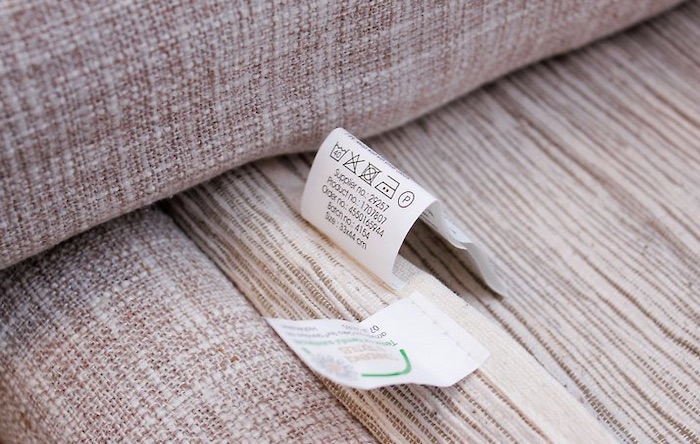
When cleaning or removing stains from your sofa, please always consult the manufacturer's cleaning instructions. If you don't, cleaning solutions may ruin your fabric couches or invalidate your couch's warranties.
Do not worry if you cannot find the manufacturer's instructions. Your sofa cushions should include a tag that informs you of crucial information, such as if the material is water soluble.
Remember that the tag may have cleaning instructions on one side for the sofa cover and instructions on the other for the cushions. Before you clean, double-check that you are reading the proper tag.
Below are a few of the most prevalent fabric cleaning codes and their meanings. The label for your fabric couch is typically attached under the cushions.
Sofa Upholstery Cleaning Codes
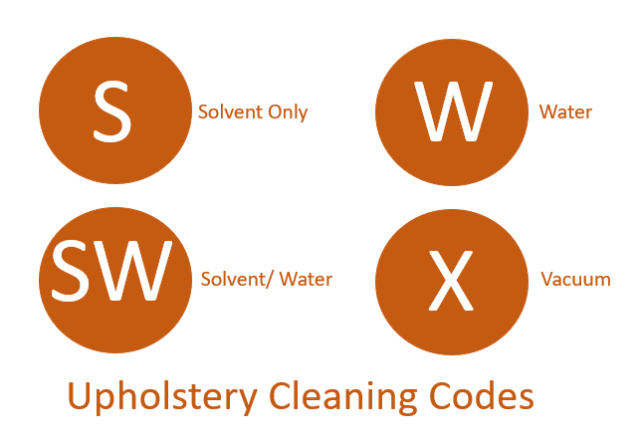
Blended materials like polyester and cotton or polyester with traces of acrylic or nylon are common in modern sofas. Since each couch fabric has exceptional durability and cleanliness qualities, keeping clean upholstery might become complicated.
So you can take the simple path and look for the solution on the cleaning tag rather than stressing over the most efficient yet fabric-safe way to remove grease stains from your 94% polyester and 6% linen couch cushions.
The best approach to cleaning a fabric sofa is recommended by furniture manufacturers, who also provide a cleaning code. A white product tag with the code for your sofa is on the platform beneath one of the cushions. It's frequently on the bottom of one of the footrests on a reclining couch.
The cleaning code for fabric couches includes the following.
- W: Clean your synthetic fabrics with a water-based solution.
- S: Clean your natural fabrics with a solvent-based dry-cleaning solution.
- S/W: Solvent and water-based cleaners will work on the fabrics.
- X: No water or solvent-based cleaners allowed, only vacuuming and brushing the fabrics.
For solvent-based "S" code fabric sofas, a water-based cleaner can cause the fabric to shrink, distort, or leave ugly water stains.
While a fabric couch with a "W" classification may not always respond well to solvent-based cleaners, you can use many of your preferred DIY cleaning solutions without worrying about damage.
2. Vacuum and brush to remove dirt and dust
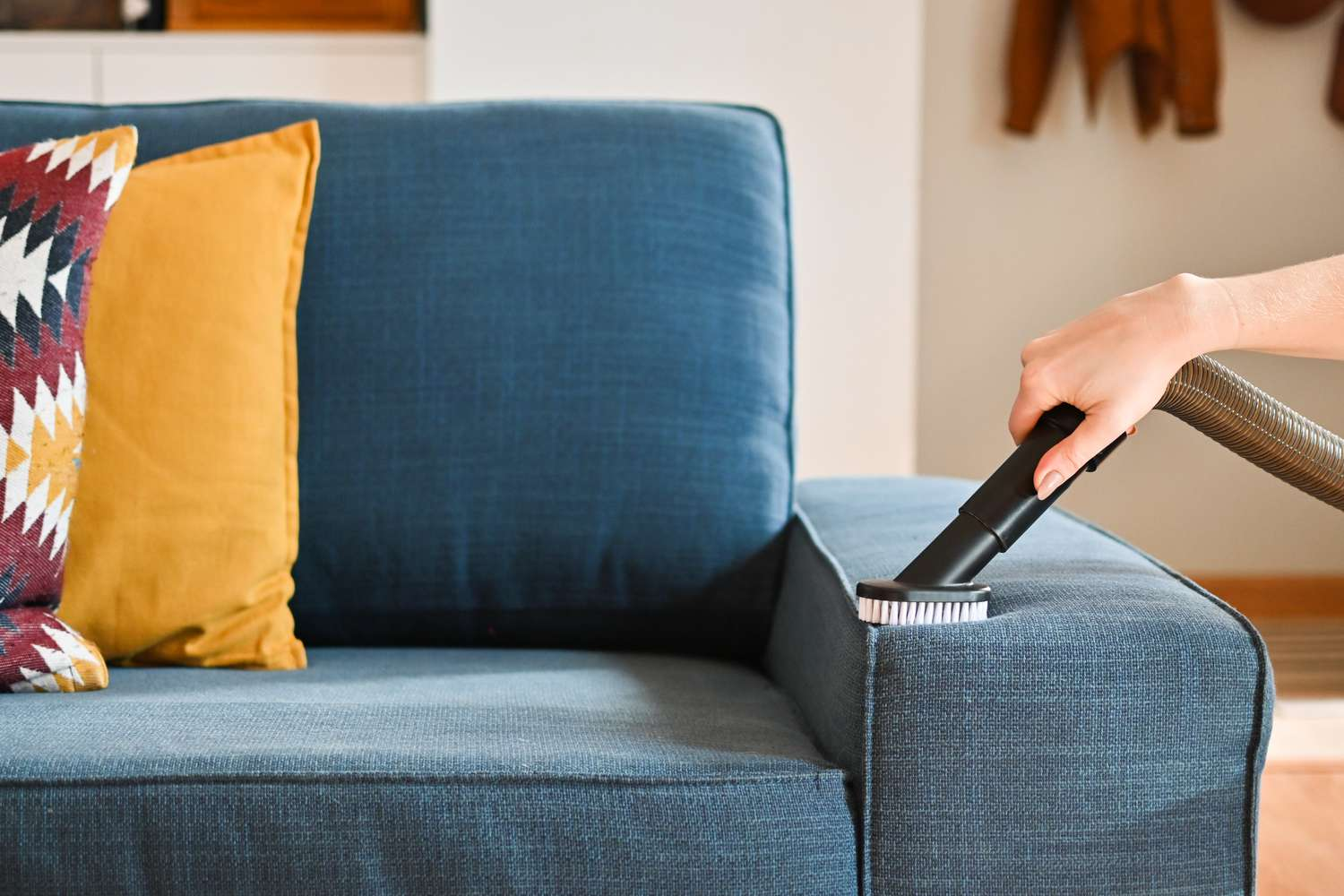
When cleaning a fabric sofa, you should begin big and end small like any other household surface. To prepare for applying a stain-cleaning solution, it is necessary to take out the vacuum cleaner and upholstery attachment and remove crumbs, grime, and pet hair. Get a separate, stiff brush if your vacuum does not have a brush attachment to help you suction up debris.
3. Deodorize using baking soda
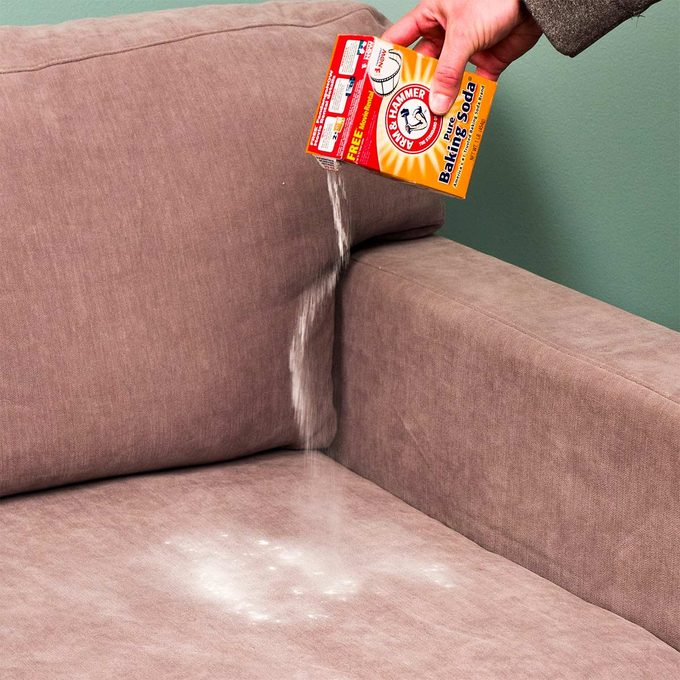
Sprinkle baking soda over your sofa's cushions to freshen up the smell. If the air around your sofa cushions begins to smell like pets or other unpleasant scents, this is the ideal solution. A good habit of keeping a fresh sofa is regularly vacuuming and cleaning with baking soda.
Let the baking soda rest and eliminate odors for at least 30 minutes. Use your vacuum's brush attachment to thoroughly clean the entire couch, picking up the baked-on baking soda and other loose dirt.
4. Remove stains using baking soda
Baking soda softly pulls the stains out of the fabric to absorb them rather than pressing into stubborn stains and maybe pushing them further into the cloth.
Combine a little warm water and baking soda to make a thick paste. Put a good amount of paste on the stain, ensuring that it covers the entire area, and then gently rub it in. After letting it sit for at least 30 minutes, vacuum the area.
For new liquid stains, use dry baking soda. Apply baking soda on the stain after wiping as much of the stain as you can using a clean cloth. Before vacuuming it, let the baking soda sit for around 30 minutes.
5. Remove stains using dish soap with vinegar and microfiber cloth
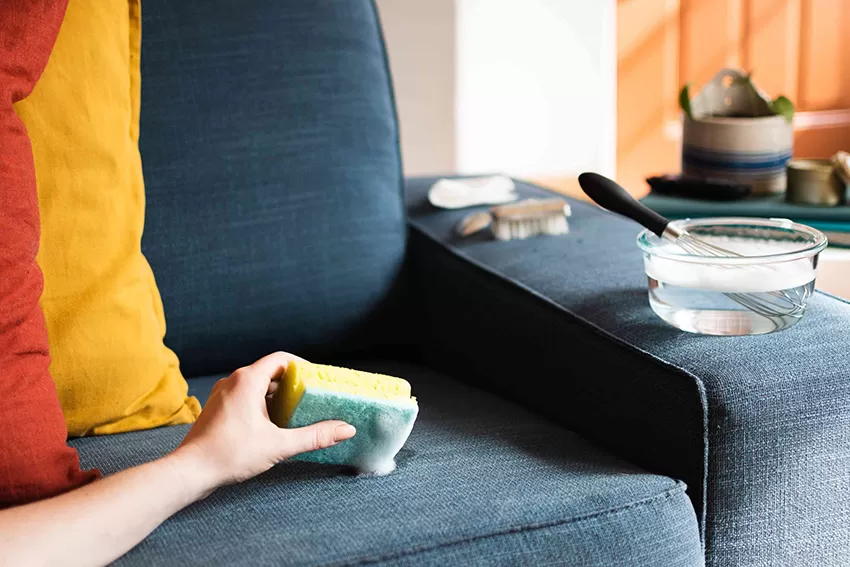
Combine white vinegar, mild dishwashing liquid, and distilled water to prepare an effective cleaning spray for water-safe fabrics.
Make an efficient DIY cleaner by mixing 1 cup distilled water, 1/2 cup white vinegar, and a few drops of mild dish soap in a spray bottle.
To combine the ingredients, shake the spray bottle. Avoid over-saturating the stain by lightly misting it with your cleaner. Let the sofa air dry after gently blotting the stain with a dry microfiber cloth.
6. Clean your natural fiber sofa with rubbing alcohol
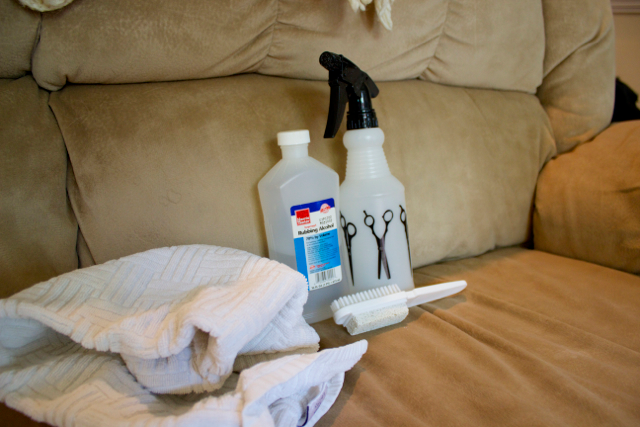
If your sofa cushions are made of natural fiber, you can save on a solvent-based cleaner or create a cleaning solution. You can use rubbing alcohol as a dry-cleaning substitute on many natural fabric sofas.
To make sure you won't cause any more harm to any S-code fabric, check the manufacturer's instructions. To ensure it doesn't leave a mark, perform the spot-testing technique in an inconspicuous area.
Mix one cup of rubbing alcohol with half a cup of water to clean a couch, then dunk a microfiber cloth into the mixture. Avoid oversaturating the stain by gently blotting it. Letting it air dry will remove any remaining moisture since the rubbing alcohol will quickly evaporate.
7. Steam clean your fabric sofa
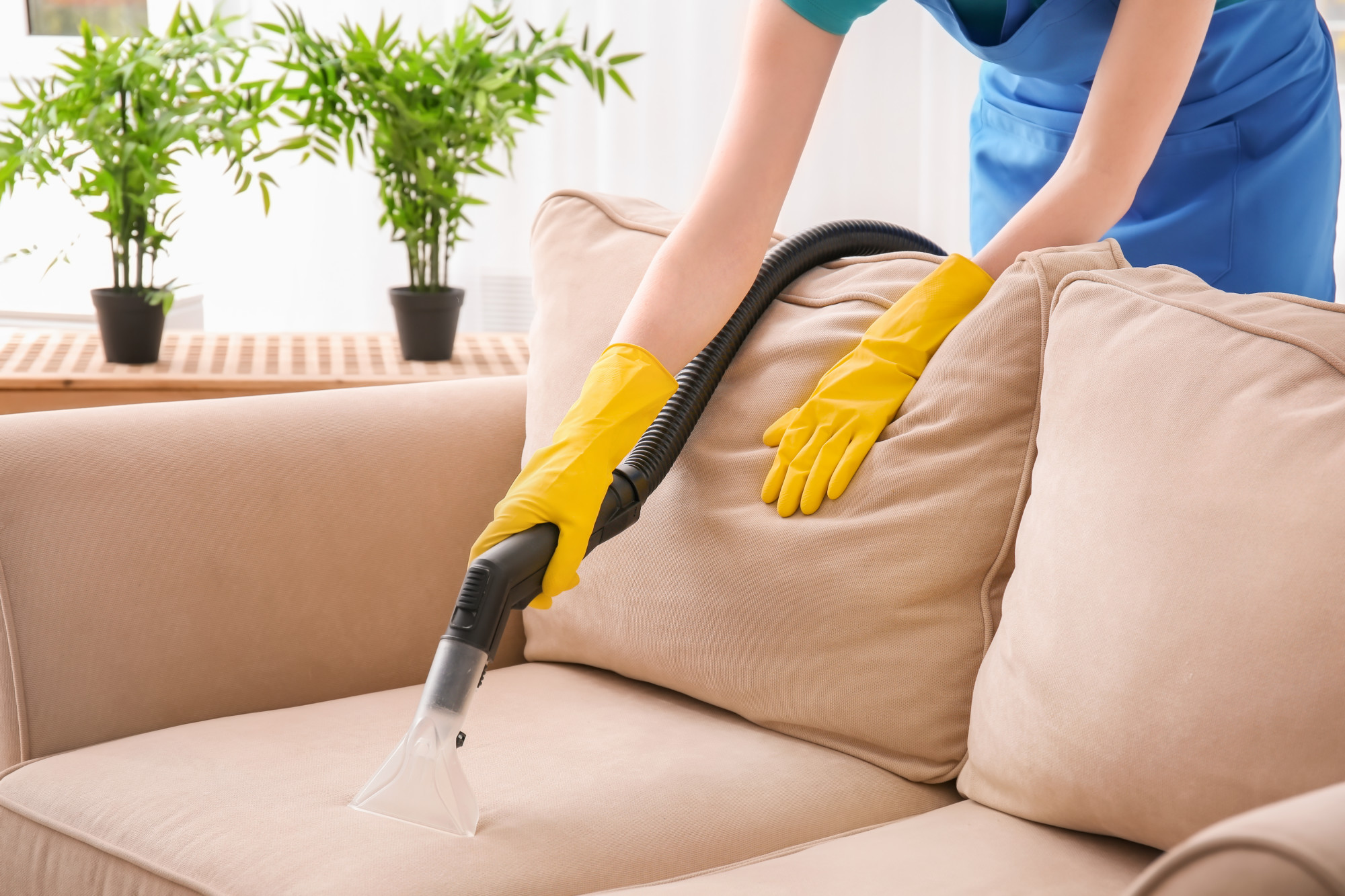
Using a steam cleaner is an excellent additional method for cleaning fabric sofas. These machines use heat and water to clean, making them suited for various materials. You can get a steam cleaner with an upholstery attachment to complete the job easier. To avoid burns, follow the machine's operating instructions and take extra precautions when keeping your distance from the hot steam.
Begin by removing the cushions and steam cleaning them one side at a time to clean a fabric sofa thoroughly. Before flipping them over and scrubbing the opposite side, give each side time to dry. Instead of repeatedly blasting one area with steam, use short, quick strokes with the steamer attachment. By doing this, the couch is kept from getting soggy.
After that, wash the sofa's frame. Perform this task in small sections to ensure that each area is completely cleaned and nothing is missed. Let the couch dry completely before replacing the cushions. A fan nearby will quicken this process.

It's Time to Give Your Entire Couch a Deep Clean
Cleaning a fabric couch doesn't have to be daunting. It can quickly be done with natural cleaning solutions.
Following the steps outlined in this article, you can keep your couch looking and smelling fresh without exposing your family and pets to harmful chemicals.
Regular maintenance, such as vacuuming and spot cleaning, can also help prolong the life of your couch and prevent the buildup of dirt and grime.
Discover the secrets to maintaining a clean and pristine living room by exploring our ultimate guide on cleaning your home's central space. These tips allow you to enjoy a clean and healthy living space for years.
FAQs
Can you use a carpet cleaner on a couch?
Yes, you can clean a couch using a carpet cleaner. Sofa upholstery may be cleaned with carpet shampooers. Check to see if your cleaner is safe for your specific sofa. The simplest way is to cross-check the cleaning code on the tag attached to the couch.
How do you clean a fabric couch that smells?
Baking soda can help eliminate odours in your couch just like it can in so many other items and features around the house. As soon as this miraculous product is put into the fabric of your couch, it starts to work, absorbing odours and removing stains. Treat your cushions, arms, backrest, and crevices with baking soda.
How often should you clean a fabric couch?
Vacuum your sofa at least once a week or anytime you clean it. If no dogs or young children live in the home, you can extend it to once every six months or yearly. It's safe to have the fabric professionally cleaned at least three to four times a year when pets or kids are around.
How to repair damaged upholstery fabric?
To repair damaged upholstery fabric, start by evaluating the size of the tear. For small tears, you can use fabric glue or a patch that matches the upholstery. Apply the glue carefully, pressing the fabric edges together, or secure the patch in place with glue or by sewing. For larger tears, sewing with a matching thread may be necessary to maintain the fabric's appearance.
If the damage is extensive knowing where to buy upholstery fabric and performing the repair might be challenging. In such cases, it's advisable to hire a professional upholsterer. They can provide both the appropriate materials and the expertise required for a high-quality restoration.


